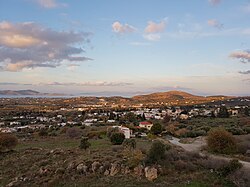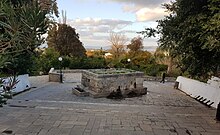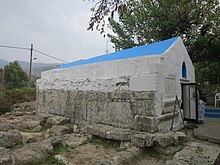Pyli (Kos)
|
Pyli Πυλί |
||
|---|---|---|
|
|
||
| Basic data | ||
| Country |
|
|
| region | South Aegean | |
| Regional district | Kos | |
| local community | Kos | |
| Parish | Dikeos | |
| Borough | Pyli (Kos) | |
| Geographic coordinates | 36 ° 51 ′ N , 27 ° 9 ′ E | |
| Height above d. M. |
75 m |
|
| Residents | 2469 (2011) | |
| LAU-1 code no. | 6401020201 | |
| View of Kos from the chapel of Agios Fanourios- | ||
Pyli ( Greek Πυλί ( n. Sg. ), Also: Pili ) is a small town on the Greek island of Kos . The place is the administrative seat of the city district of the same name.
Location, geography, traffic
Pyli is located around 15 kilometers southwest of the city of Kos and around 4 kilometers south of Marmari at around 70 to 80 meters above sea level (center of the city).
The place is relatively central between the Kefalos peninsula in the southwest and the capital Kos in the far east. The main road of the island, which runs between Kos and Kefalos , passes near Pyli.
history
In the immediate vicinity of today's Pyli, ancient arches were found, on the Psoriari hill ( Greek λόφο Ψωριάρη ) remains of an ancient sanctuary in honor of the goddess Demeter and Persephone . Archaeological excavations also have coins from around 200 BC. Found. This shows that today's Pyli was also settled in earlier times. It was then called Peli .
Another place Pyli developed in the Middle Ages around the Byzantine castle Peripatos, which was built between the 9th and 11th centuries. The castle fell into disrepair in the course of further development and was rebuilt when the Order of St. John occupied Kos. After the revolution in 1821 the old village of Pyli ( Palio Pyli ), which like the whole island of Kos belonged to the Ottoman Empire , was depopulated by the Ottoman authorities and was finally abandoned in 1830 after the outbreak of cholera . The Greek inhabitants founded the new Pyli ( Greek Νέο Πυλί ), also called Lower ( Kato / Greek Κάτω ). Since May 7, 1912, Pyli, like the rest of the island of Kos, was occupied by Italy and was annexed to Greece on March 7, 1948.
Population and political structure, economy
Pyli belongs to the municipality of Dikeos, which was home to 7,130 people (2011). The municipality of Dikeos is subdivided into municipal districts. 3036 people lived within the urban district of Pyli (Δημοτική Κοινότητα Πυλίου) (2011). The municipality includes the small town of Pyli (Πυλί) with 2469 people (2011) and the village of Marmari (Μαρμάρι) with 567 people (2011).
| year | 1951 | 1961 | 1971 | 1981 | 1991 | 2001 | 2011 |
|---|---|---|---|---|---|---|---|
| population number |
2049 | 1883 | 1508 | 1816 | 2453 | 2431 | 2469 |
The main branch of the economy is agriculture and livestock farming, and more recently tourism. A significant proportion of the people who sought protection in the European Union as part of the refugee crisis in Europe from 2015 and who came to Kos are temporarily resident in Pyli (2019).
Attractions
- Palio Pyli ( Greek Παλιό Πύλι ), abandoned village with ruined Johanniter castle,
- Pyli reservoir ( Greek Λίμνη του Πυλίου ).
- Hometown in Pyli ( Greek Πυλιώτικο Σπιτι ), the rural way of life of a family until the 1950s is shown.
- old well in the center of the village, the water gushes from stone snapdragons. The well dates from the time of the Ottoman rule and was built around 1592 (see: Pyli source ).
- Tomb of Charmylus, son of Chairylus, the legendary hero and king of Kos in ancient times. The rectangular tomb with a barrel vault, called Charmyleion, dates from the late 4th century to the beginning of the 3rd century BC.
literature
- Nikos Varelas: Kos. DumontExtra, DuMont Buchverlag Cologne 2002. ISBN 3-7701-5759-1
Web links
Individual evidence
- ↑ Results of the 2011 census at the National Statistical Service of Greece (ΕΛ.ΣΤΑΤ) (Excel document, 2.6 MB)
- ↑ Πυλί , website: kos.gr.
- ↑ Κάστρο του Πυλίου και Παλαιό Πυλί - Πυλί , website: kos.gr.
- ↑ Kostas Buraselis: Kos Between Hellenism and Rome. Studies on the Political, Institutional, and Social History of Kos from Ca. the Middle Second Century BC Until Late Antiquity , American Philosophical Society, 2000, Volume 90, Part 4, pp. 21-22.
- ↑ Castle of Pyli and Old Pyli , website: www.kos.gr.
- ↑ Ιάκωβος Ε. Ζαρράφτης: Κωϊων, B 'Mέρος. Ιστορία της Κω από των αρχαιοτάτων μέχρις ημών , website: anemi.lib.uoc.gr.
- ↑ Population of Pyli Greek Statistical Office ELSTAT, Digital Library ; Census 2011 (Greek)
- ^ City of Pyli , website: viagallica.com.



